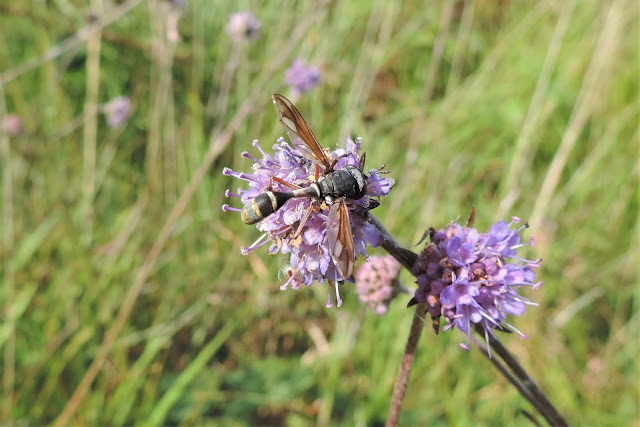The Blaencaerau 1km square is the second square in the valley where I have recorded 100 species of hoverfly, following on from Garnwen (SS8392) in 2018. The area comprises of damp grassland and sparse sallow woods on former colliery spoil, surrounded by upland moorland and conifer plantation, with 2 small rivers flowing through the square. The area is 250mts above sea level and is rich in flora from March through to October.
Records begin in week 11 (Mar 12-18), when small numbers increase rapidly from week 20 (May 14-20), peaking in week 24 (Jun 9-15), than after a lull in numbers between broods around week 28 (Jul 7-13). Numbers really pick up with the summer brood and stay high thereafter until week 38 (Sep 17-23) and then drop off rapidly with no new flowers blooming, making it difficult to detect any new species. The last records come from week 40 (Oct 1-6).
Spring (Mar-May)
Main feeding flowers - Dandelion, Dogwood, Hawthorn, Meadow Buttercup, Sallow
Specialist species of the season - Anasymia contracta, Cheilosia albipila, Chrysogaster virescens, Criorhina floccosa, Didea fasciata, Eumerus strigatus, Melangyna lasiophthalma, Parhelophilus versicolor, Platycheirus tarsalis, Xanthogramma citrofasciatum.
Summer (Jun-Aug)
Main feeding flowers - Bramble, Creeping Thistle, Fine-leaved Water Droplet, Grasses, Hogweed.
Specialist species of the season - Cheilosia carbonaria, Cheilosia longula, Chrysotoxum cautum, Eriozona syrphoides, Megasyrphus erratica, Microdon myrmicae, Parasyrphus lineola, Pipizella viduata, Platycheirus manicatus, Sericomyia lappona.
Autumn (Sep-Nov)
Main feeding flowers - Angelica, Common Fleabane, Common Ragwort, Devilsbit Scabious, Goldenrod.
Specialist species of the season - Chrysotoxum arcuatum, Eristalis intricaria, Eristalis rupium, Eupeodes latifasciatus, Ferdinandea cuprea, Rhingia rostrata, Scaeva pyrastri, Scaeva selenitica, Sericomyia silentis, Xanthogramma pedissequum.
***** Species marked in red are rare for Glamorgan and even Wales in some cases. *****
























